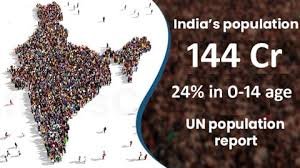Unfpa Report: India’s Population Trends and Reproductive Health Inequities
India, a country marked by its diversity, is undergoing significant shifts in its population dynamics. A recent report by the United Nations Population Fund (UNFPA) sheds light on these trends, focusing particularly on reproductive health inequities. Understanding these trends is crucial for aspirants preparing for various government exams, including civil services, as they often include questions related to population policies, health, and social issues.
The report highlights several key findings regarding India’s population:
- Population Growth Trends: India continues to be one of the most populous countries globally, with a current population of over 1.3 billion. However, the rate of population growth has been slowing down in recent years, attributed to various factors such as increased access to education and healthcare, urbanization, and changing societal norms.
- Regional Disparities: One significant aspect highlighted in the report is the regional disparities in population growth and reproductive health outcomes. States in northern India tend to have higher fertility rates compared to those in the south, leading to uneven demographic transitions across different regions.
- Gender Disparities: The report also underscores the persistent gender disparities in access to reproductive healthcare services. Women in rural and marginalized communities often face barriers in accessing quality maternal healthcare, leading to higher maternal mortality rates and health inequities.
- Youth Population: India has a large youth population, with a significant proportion under the age of 25. While this demographic dividend presents opportunities for economic growth and development, it also poses challenges in terms of education, employment, and healthcare provision for this segment of the population.
- Policy Implications: The findings of the UNFPA report have significant policy implications for India’s government. Addressing reproductive health inequities, promoting gender equality, and ensuring access to quality healthcare services for all segments of the population should be prioritized in national development agendas and policies.
As aspirants prepare for government exams, staying informed about such demographic trends and their implications is crucial. Questions related to population policies, healthcare, and social inequalities are often included in various competitive exams, making it essential for candidates to have a comprehensive understanding of these issues.

Why this News is Important:
Understanding Population Dynamics: India’s population trends have far-reaching implications for various sectors, including healthcare, education, and employment. Aspirants preparing for government exams need to grasp these trends to answer questions related to population policies and their impact on society.
Reproductive Health Inequities: The UNFPA report highlights the disparities in access to reproductive healthcare services, particularly for women in rural and marginalized communities. This underscores the importance of addressing gender inequalities and ensuring equitable access to healthcare for all.
Historical Context:
India has long grappled with population issues, dating back to the mid-20th century when concerns about overpopulation and its impact on development first emerged. In response, the government implemented various population control measures, including the promotion of family planning and contraception. However, these efforts have often faced challenges due to cultural, social, and political factors.
5 Key Takeaways from “Unfpa Report: India’s Population Trends and Reproductive Health Inequities”:
| Serial Number | Key Takeaway |
|---|---|
| 1. | India continues to be one of the most populous countries globally, with a current population of over 1.3 billion. |
| 2. | Regional disparities exist in population growth and reproductive health outcomes across different states. |
| 3. | Gender disparities persist in access to reproductive healthcare services, particularly for women in rural areas. |
| 4. | India has a large youth population, presenting both opportunities and challenges for economic and social development. |
| 5. | Addressing reproductive health inequities and promoting gender equality are crucial for India’s development agenda. |
Important FAQs for Students from this News
Q1: What are the main findings of the UNFPA report on India’s population trends?
- A: The report highlights India’s population growth, regional disparities, gender inequalities in access to healthcare, the youth population, and policy implications.
Q2: Why is understanding India’s population dynamics important for government exam aspirants?
- A: Understanding population trends helps aspirants answer questions related to population policies, healthcare, and social issues, which are often included in competitive exams.
Q3: How does the report address reproductive health inequities in India?
- A: The report underscores disparities in access to reproductive healthcare services, particularly for women in rural and marginalized communities, emphasizing the need for gender equality and equitable healthcare access.
Q4: What historical context is provided regarding India’s population issues?
- A: India has a history of grappling with population concerns since the mid-20th century, leading to the implementation of various population control measures and policies.
Q5: What are the key takeaways for government exam aspirants from the UNFPA report?
- A: Key takeaways include understanding India’s population size, regional disparities, gender inequalities in healthcare access, the significance of the youth population, and the importance of addressing reproductive health inequities.
Some Important Current Affairs Links


















